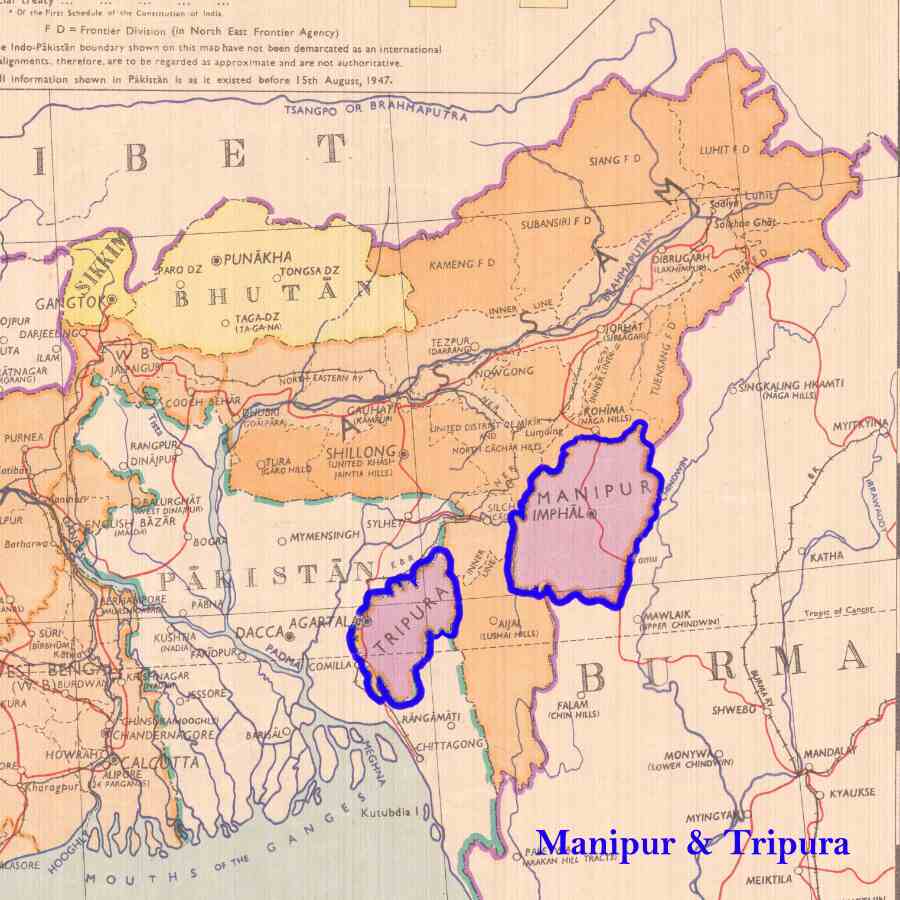Formation of Commissionerates
Following thew previous article, this week we discuss the formation of Part-C states of Tripura, Manipur, Vindhya Pradesh, Coorg and Delhi

With the creation of East Bengal, Tripura was virtually isolated from India, and its extensive zamindari of 600 square miles was left in East Pakistan. As the Maharaja was a minor, the merger agreement was signed by his mother, the daughter of the Maharaja of Panna, who was the regent. The capital Agartala, as well as other important places in the state, lay in the narrow belt of land adjoining Pakistan, with which it shared a 700-mile border. Tripura also shared a common border with Assam, but till that time, there was no road link with Assam, and all supplies had to be airlifted from Calcutta (as Kolkata was then called).
The Tripura Access Road to be built for Rs one crore was, therefore, the foremost priority, and given the strategic importance of the state, it was made into a Part C state, although Assam was quite keen for its merger with that state. While the state had a Chief Commissioner, there was an Advisory Council, the most prominent member of which was Sachindra Lal Singh, who subsequently became the first CM of Tripura when it became a Union territory in 1963.
Manipur was also an underdeveloped border state with an area of 8,628 square miles of which just about seven square miles were in the valley, and the rest of it was in the hills. The ruling Meiti family had converted to Vaishnavism from the 18th century and adopted titles like Maharaja, Shrijut, Manipureshwar etc. The hill tribes fell into two distinct categories – the Kukis and the Nagas. It was bounded on the north by the Naga district of Assam, on the east by Burma (as Myanmar was then called) on the south by Burma and Lushai Hills (Mizoram) and on the west by the Cachar district. After the controversial merger agreement signed by Maharaja Bodh Chandra Singh, it became a CC province, with the erstwhile Dewan of Manipur Rawal Amar Singh as the first Chief Commissioner. However, a movement against the lack of representation in state administration was led by Rishang Keishing, then a young socialist leader. As a member of parliament from 1952 from the state, he kept trying to narrow down the apparently irreconcilable differences between the Meitis of the Imphal valley and the Nagas and Kukis of the hills.
Then there was Vindhya Pradesh, which from the very inception was mired in controversies and corruption. The administration of most of the states in Bundelkhand and Bahgelkhand was nothing more than the court politics and intrigues of the Rulers without any element of public participation. In fact, there was a strong move to dismember the Union and split the constituent units between UP and MP, but this was not resorted to on account of the impact it may have on the other Unions. The States Ministry also felt that if the British had managed to keep over 500 states for over a century, surely they could retain six unions of states for at least a decade! Therefore, the decision was taken to convert this Union into a Part C state – even though it had the size (24,598 square miles) the population (35,69,455) and the annual revenue of Rs 2,43,30,734 to function as a Part B state. There was an element of urgency as, after the promulgation of the Constitution, the process of changing the territory/status would require a Constitutional amendment. The first Chief Commissioner was NB Bonnarjee of the ICS, and after the first general elections, SN Shukla of the Congress became the first Chief Minister.
With regard to Coorg, it was a territory directly governed by the British from the year 1843. There was a strong movement for its merger with the Kannada-speaking areas, but the counter-movement of retaining its independent identity was also quite pronounced. Known for its picturesque settings, coffee plantations and the birthplace of Generals Cariappa and Thimmaiah, Coorg elected pro merger Congress leader CM Poonacha as the first CM.
Last but not least, in the list of Part C states was Delhi which was also the seat of political power and the national capital. Chaudhary Brahm Prakash became the Chief Minister of Delhi at the young age of 34. While he did make a strong pitch for enhanced powers for the legislative assembly of Delhi, the Union Government did not want to give up powers over land and law and order because, in the immediate aftermath of the partition, it was felt that Delhi deserved special consideration, and also that the investments required to create India's first city would be far beyond the reach of the Delhi government, which at that time did not have a strong industrial or commercial base.
Views expressed are personal



